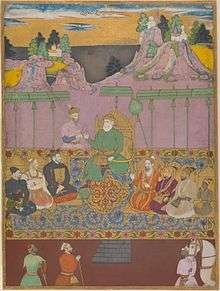Sikandar Adil Shah
Sikandar Adil Shah was placed on the throne of Bijapur in 1672 at four years of age. Therefore, his reign (1672–1686) is one of regents and ministers and was marked by chronic civil war among factious nobles, independence of provincial governors, paralysis of the central administration, Mughal invasions, secret alliances but pretend hostilities with the Maratha Empire and other neighbors, and the final absorption of Bijapur into the Mughal Empire in 1686.
| Sikandar Adil Shah | |||||
|---|---|---|---|---|---|
| Sultan of Bijapur | |||||
 A painting of "The House of Bijapur" was completed in the year 1680, during the reign of Sikandar Adil Shah the last ruler of the Adil Shahi dynasty. | |||||
| Reign | 1672–1686 | ||||
| Predecessor | Ali Adil Shah II | ||||
| Successor | Mughal Empire | ||||
| Born | c.1668 | ||||
| Died | c.1700 (aged 31–32) Bijapur | ||||
| Burial | Sikandar Bag | ||||
| Spouse | Daughter of Abul Hasan Qutb Shah | ||||
| Issue | One son Sultan Muhammad and a daughter | ||||
| |||||
| House | Adil Shahi | ||||
| Dynasty | Adil Shahi | ||||
| Father | Ali Adil Shah II | ||||
| Mother | Khursheeda Khanum | ||||
| Religion | Shia Islam | ||||
The prestige of Bijapur was so seriously damaged by internal disruptions that the Mughal General Diler Khan almost coerced and humiliated Sikandar. Despite several sacrifices and desperate attempts on the part of Sikandar, he could not satisfy the growing greed of the Mughals. Sikandar's alliance with Sambhaji (who was Hindu) further aggravated Mughal-Bijapur relations.
At last, Emperor Aurangzeb himself marched out in 1685 with a large army to fulfill the ambition of his life. After desperately defending his capital and withstanding the prolonged siege of Bijapur in 1685–1686, Sikandar was unable to halt the Mughal assault led by Aurangzeb. On 12 September 1686, Bijapur was occupied, its garrison surrendered and Bijapur Fort was annexed by the Mughal Empire.
Sikandar Adil Shah was captured bound in silver chains and brought before the Mughal Emperor Aurangzeb, to whom he bowed three times. Aurangzeb then sent him and his followers to Daulatabad fort, where he died during captivity.[1] Sikandar Adil Shah and was eventually buried at foot side of his spiritual teacher Naimullah Hashmi in the open yard in the New Market Place of Bijapur. The Adil Shahi dynasty thus came to an end.
References
- Aurangzeb - Muni Lal - Google Books. Books.google.com. 1 December 2002. Retrieved 20 November 2011.
- Wakiyate Mamlakate Bijapur by Basheeruddin Dehelvi.
- Tareekhe Farishta by Kasim Farishta
- External Relation of Bijapur Adil Shahis.
| Preceded by Ali Adil Shah II |
Adil Shahi Rulers of Bijapur 1672–1686 |
Succeeded by Aurangzeb captured Bijapur |